Archive for the 'Floppy Emu' Category
Floppy Emu and Disk Daisy Chainer Restock
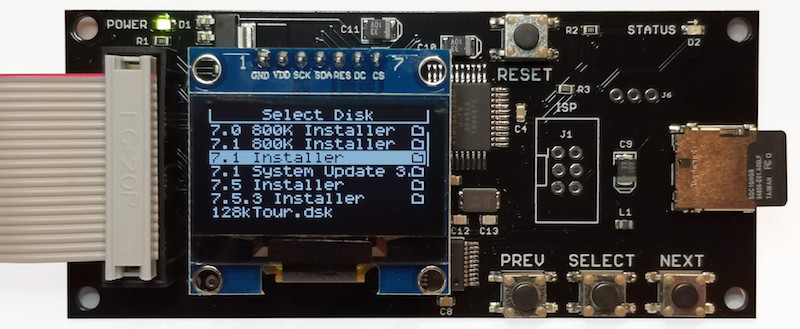
After a few weeks’ absence, the BMOW Floppy Emu disk emulator for vintage Apple computers is back in stock. Get yours now at the BMOW store. This is the latest version Floppy Emu Model C, with OLED display.
Floppy Emu is a floppy and hard disk emulator for classic Apple II, Macintosh, and Lisa computers. It uses an SD memory card and custom hardware to mimic an Apple floppy disk and drive, or an Apple hard drive. The Emu behaves exactly like a real disk drive, requiring no special software or drivers.
Disk Daisy Chainer
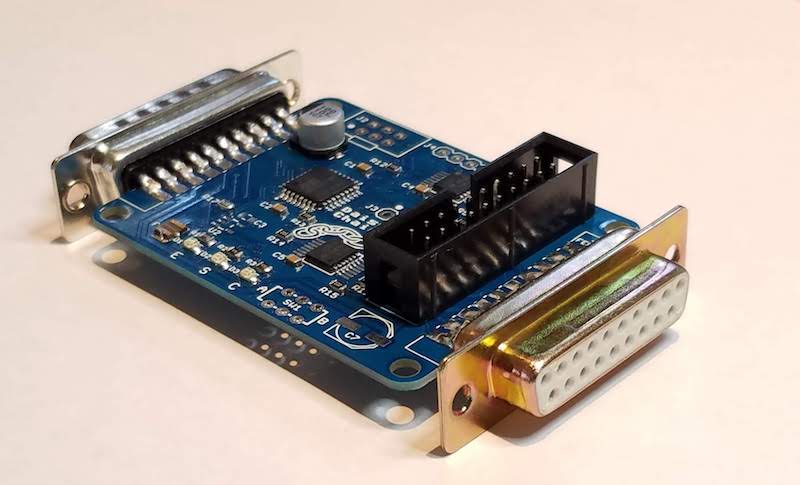
The Daisy Chainer adapter for Floppy Emu is now available for public sale, after a long period of limited release. The Daisy Chainer board makes it possible to insert a Floppy Emu anywhere into your daisy chain of Apple II drives, with other floppy drives before and/or after it in the chain. It provides a nice improvement in flexibility for Apple IIGS owners and other Apple II users with complex drive setups.
The Daisy Chainer is a smart device with an onboard microcontroller for decoding the drive enable signals. It automatically senses the type of disk drive connected to its downstream daisy chain port, as well as the current emulation mode of the connected Floppy Emu. Some past blog posts about Daisy Chainer development are available here: part 7, part 6, part 5,
part 4, part 3, part 2, and part 1.
Introducing Noisy Disk
Do you miss the iconic sounds of mechanical click-clacking from original Apple II floppy drives? Does the familiar rattling of a boot floppy bring a smile to your face? Today I’m introducing a new product called Noisy Disk. This board uses a mechanical relay to create authentic-sounding disk head movements for the BMOW Floppy Emu disk emulator. Sure it’s useless, but it’s useless fun.
The Noisy Disk board attaches inline with your existing Floppy Emu cable, using the provided 6-inch extension cable. When Floppy Emu is configured to emulate a 5.25 inch Apple II floppy drive, the Noisy Disk onboard relay snaps open and shut whenever the emulated disk steps from one track to the next. It creates a symphony of disk noise that will bring back memories of 1979.
Noisy Disk is compatible with Apple II family computers while using Floppy Emu in 5.25 inch emulation mode. Nothing will be harmed if Noisy Disk is used with other computers or emulation modes, but you’ll hear strange clacking noises that don’t match the disk activity. It’s recommended to use Noisy Disk in 5.25 inch emulation mode only.
The product includes the Noisy Disk board with 2 x 10 pin rectangular input and output connectors, and a 6-inch extension cable for connecting to your Floppy Emu board.
Noisy Disk is available now at the BMOW Store.
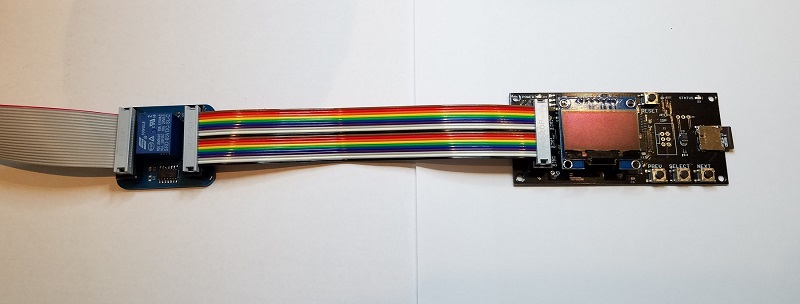
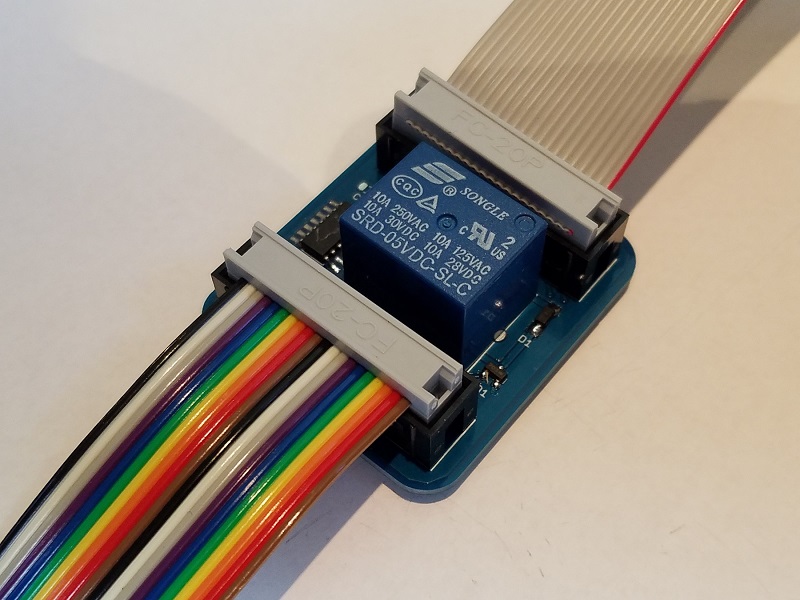
Seeking Daisy Chainer Early Adopters

If you’ve been waiting for a Daisy Chainer for your BMOW Floppy Emu disk emulator, I’m happy to report that it’s ready to go. The Daisy Chainer board makes it possible to insert a Floppy Emu anywhere into your daisy chain of Apple II drives, with other floppy drives before and/or after it in the chain. It provides a nice improvement in flexibility for Apple IIGS owners and other Apple II users with complex drive setups.
I have a couple of hand-assembled Daisy Chainers available for sale now, and I’m seeking a few early adopters who have time to exercise it this week with their computer and drives. I need to make sure these first units get into the hands of people who can try them ASAP and confirm compatibility with their equipment, before I move ahead with manufacturing more. If you’ve got the time and the desire, send me a note!
Read 15 comments and join the conversationFloppy Emu May Feature Update

New features are blooming like May flowers for the Floppy Emu disk emulator. This firmware update has something for everyone!
Lisa
The emulated rotation speed of Lisa floppy disks can now be manually adjusted within a range of +/- 6 percent. This only affects the TACH signal that the Lisa uses to sense the drive speed – it has no effect on the actual bit rate which remains 500 Kbps. The speed adjustment is set after selecting “Lisa floppy” as the emulation mode. Adjustments may help some Lisa owners with hardware different from my test system and who reported disk speed errors.
Apple II
- Smartport disk images can now have descriptive names like “SMART0-game-archive.PO”. So long as the filename begins with “SMART” plus a unit digit 0 through 3 it will be used for that Smartport unit. The rest of the name is ignored.
- Added support for 40-track / 160K 5.25 inch disks
- bug fix: NIB disks can now be ejected normally
All computers with Floppy Emu Model C
The OLED display will be dimmed after 30 seconds of inactivity. Any disk I/O or user interaction will return it to normal brightness.
Download the new firmware:
Mac/Lisa firmware: mac-lisa-0.8F-F14
Apple II firmware for Floppy Emu Model B and C: apple-II-0.2I-F25
Apple II firmware for Floppy Emu Model A: apple-II-0.2I-F22
Daisy Chainer Testing

Good news: the Daisy Chainer for Floppy Emu is finished, and working nicely in all my tests. With the Daisy Chainer, a mix of real and emulated disk drives can be combined into a single Apple II daisy chain for maximum flexibility. The real drives can be attached before or after the Floppy Emu.
I have a few Daisy Chainer boards available for sale now. Send me an email if you’re interested in getting one (use the Contact link at the page’s upper-right).
Not-so-good news: newly-assembled Daisy Chainer boards are a pain to test, and this is something I didn’t account for. A true functional test requires connecting the board to a Floppy Emu, an Apple II, and a variety of other disk drives, and then running through many different permutations of daisy chain configuration and disk emulation modes. It requires 15 minutes or more. That’s OK for a few hand-assembled units, but there’s no way I can do that for a larger production run.
To support faster testing, I’ve designed two special test boards that plug into the male and female DB19 connectors on the Daisy Chainer. These will enable some automated loopback testing of the main board using its own microcontroller. It won’t be a perfect test, but combined with some other automated tests for things like pin-to-pin solder shorts it should detect most likely assembly defects.
The problem is that in order to support the automated testing with the special test boards, I need to make some modifications to the Daisy Chainer PCB. I’ve finished that work, but I’m waiting for PCB delivery and then I need to assemble a second prototype. So it will probably be at least a month until full production of more Daisy Chainers is possible.
This is the first time I’ve ever been forced to redesign a PCB not because there was a problem with the device itself, but simply because the device was difficult to test efficiently. Lesson learned: when designing anything that you expect to build more than 10 units of, planning for testing should be an integral part of the design process.
Read 2 comments and join the conversationFloppy Emu Firmware Update: Smartport Unit 2 Mode
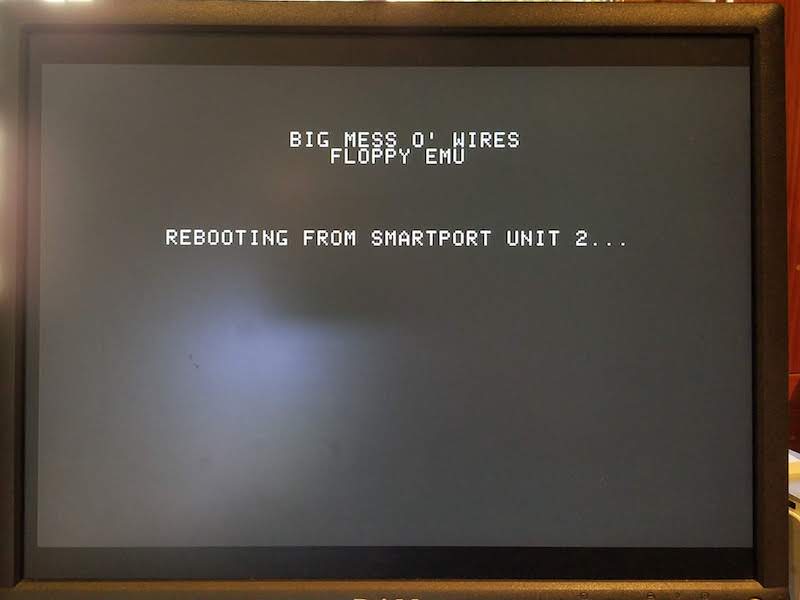
Celebrate Friday with a firmware update for the Floppy Emu disk emulator! This firmware adds a handy new disk emulation mode for Apple IIGS computers called Smartport Unit 2 mode. It’s what I called “chameleon mode” in an earlier post, and it’s very helpful for one specific configuration: you’re using the Floppy Emu as a Smartport hard disk, and the Emu is “unit 2” daisy-chained behind an Apple 3.5 inch floppy drive. With the new firmware, it’s now possible to boot from Smartport unit 2!
Normally an Apple IIgs in this configuration could only boot from the Apple 3.5 inch floppy drive (the 1st drive unit in slot 5), limiting the configuration’s usefuleness. Smartport Unit 2 mode causes the Floppy Emu to initially appear as a 5.25 inch drive in slot 6, which the IIgs will boot from, and load a small bootstrap program. This program will modify the Smartport unit priority table in RAM to give Unit 2 priority over Unit 1, and then reboot from slot 5. Presto, unit 2 boots.
You should only use Smartport Unit 2 mode when the Floppy Emu is daisy-chained behind an Apple 3.5 inch floppy drive. In all other cases, continue to use regular Smartport mode.
Get the firmware here: apple-II-0.2H-F25-modelBC
Note this firmware also contains some changes needed to support the forthcoming Daisy Chain Adapter. There shouldn’t be any visible differences, but be on the lookout for possible problems with daisy chaining, so you can revert to the previous firmware version if needed.
Read 6 comments and join the conversation
